Some people might find it fun to read about human reproduction but some might cringe out (just like I used to in the beginning). Human reproduction is not about what you are probably thinking about instead we all should know this basic things about both other genders as an awareness about the diseases which can be linked to it and how it can be prevented, might talk about it in the end but first lets get to know the basic about a male reproductive system.
Keep reading this article because I have embedded my handwritten notes at the end of this article. 🙂
Table of Contents
Constituents of the male reproductive system:
External:
Penis:
- It is the external component of the male reproductive system.
- It is made of two special type of tissues which are corpora cavernosa and a median corpus spongiosum which helps in insemination of the sperms.
- The part which bulges at the end of the penis is called the glans penis and this glans penis is covered by a loose fold of skin which is called as the foreskin.
Scrotum:
- The scrotum consists of testis which hangs behind the penis like a pouch.
- The scrotum protects the testis and acts like a thermo-regulator meaning it helps in keeping a proper temperature for the testis which is 35℃ .
- The regulation in temperature is necessary because it will later useful for the formation of the sperms.
Epididymis:
- It is present at the back of the testis which connects to the vas deferens.
- It stores the sperms and also carries it.
Testes:
- The testes is where testosterone is produced.
- The testes are the male gonads which are situated in the scrotum.
- A transverse section of testis shows difference stages of spermatogenesis.
Internal:
Vas deferens:
- It is used for transportation of the sperms to urethra for ejaculation.
Seminal vesicles:
- The seminal vesicles are present at the base of the bladder.
- They are sac-like pouches which attaches to the vas deferens.
- The vesicles produces nutritious molecules such as fructose which gives energy to the sperm.
Prostate gland:
- It is a walnut-sized structure which is located below the urinary bladder in front of the rectum.
- It consists of 20-30 lobes which open into the urethra individually.
- It produces a fluid called prostatic fluid which is whitish in colour which makes up 30% of total volume of the semen.
- The secretion neutralizes the acidity of the vaginal secretion during coitus.
Bulbourethral gland:
- This is also known as the Cowper’s gland.
- They are pea-sized structure which are located on the sides of the urethra and exactly below the prostrate gland.
- They produce a slippery fluid which is clear and it empties in the urethra. This fluid is neutralizes the acids which might be present in the urethra due to urination before ejaculation. This fluid is also used as an lubricant.
Male reproductive system:
Penis:
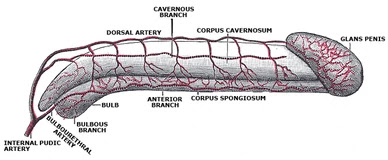 |
| Human penis |
The human penis is a cylindrical, erectile and a pendulous organ which means it keeps on hanging downwards. The penis is the external component of the male reproductive system or also known as external genetalia.
It is made up of special types of tissues which are corpora cavernosa and a median corpus spongiosum which helps in the erection of the penis during copulation i.e. coitus.
The penis serves as both as a urinary duct and as a reproductive organ. It is an intromittent organ meaning it is the external organ which is used for delivering sperms during sex. The urethra is the one which carries both the sperms and the urine.
The human penis is an exception because it does not have any erectile bone or baculum. The human penis is larger than any other primate.
Even though the penis is a part of the male reproductive system, there are different parts of the penis which you need to know, you know just for general knowledge. So, here are parts of the penis:
- The penis is made up of three columns of tissues. Two corpora cavernosa that lie next to each other on the dorsal side and one corpus spongiosum which lies on the ventral side.
- The penis has an enlarged end which is known as glans penis and the skin covering the glans penis is known as the foreskin.
- The glans penis is formed by corpus spongiosum and is the bulbous end meaning the bulging end.
- The area on the lower side of the penis from where the foreskin is attached is called frenum.
- The round base of the glans penis is called corona.
- The urethra passes through the length of the penis. It is the last part of the urinary duct from the urine and semen is removed out of the body.
- Urethral opening is called meatus. This is small opening in the middle of the glans penis.
Scrotum (ball-sac):
 |
| Scrotum |
Testis:
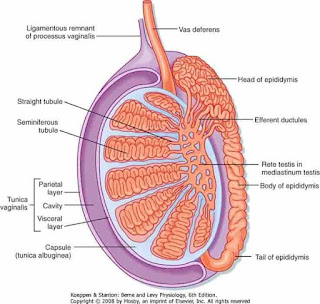 |
| Testes |
- Tunica vaginalis – This is the outer covering of the testes which is a double membrane layer made up of fibrous connective tissue.
- Tunica Albuginea – This layer lies under the tunica vaginalis making it the middle layer of testes.
- Tunica vasculosa – This layer is the innermost layer and contains many networks of blood capillaries.
 |
| Descending of testis |
Epididymis:
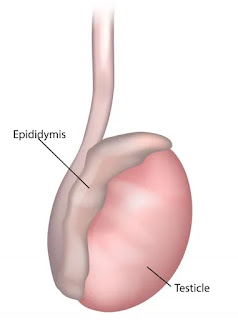 |
| Epididymis |
The epididymis are a pair of “C” shaped structure lying posterior to the border of each testis. It is 6 meters long and highly coiled ducts on both side of the testes. Testosterone the male sex hormone is produced in the epididymis.
The epididymis has three regions, which are as follows:
- The upper region which is wide and is the head or caput epididymis that receives the vasa efferentia.
- The middle region which is the narrow body of the epididymis or corpus epididymis.
- The lower region which is duct which is also wider called the tail or the cauda epididymis.
Vas deferens:
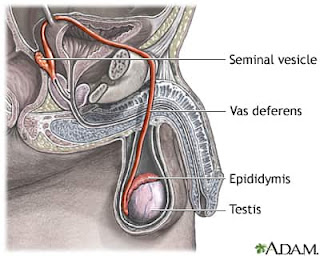 |
| Vas deferens |
Bulbourethral gland:
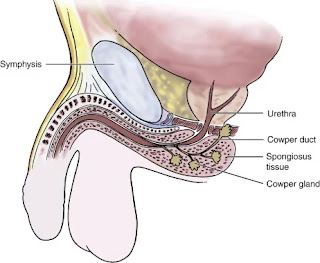 |
| Bulbourethral gland |
Prostate gland:
 |
| Prostate gland |
Seminal vesicles:
 |
| Seminal vesicle |
Seminiferous tubules:
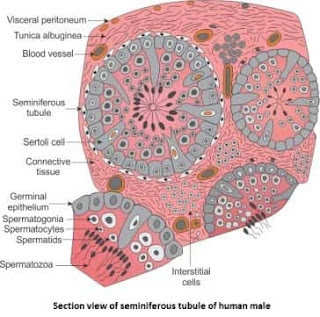 |
| Seminiferous tubules |
Ejaculatory duct:
 |
| Ejaculatory duct |
These are a pair of ducts which are about 2cm long and are formed by joining of vas deferens and a dust of seminal vesicle.
Both ejaculatory ducts open into the urethra in the region where the prostate gland is situated. They carry the seminal fluid and sperms to the urethra.
Urethra:
 |
| Urethra |
- The first part – The first part is surrounded by prostate gland and is called the prostatic urethra which only contains urine.
- The second part – The second part is a membranous urethra which is situated between the end of the prostate gland and at the beginning of the penis or the root of the penis. It carries both semen and urine.
- The third part – The third part is the penile urethra which is situated throughout the penis and carries both semen and urine.
Semen:
 |
| Semen |
Why is the male reproductive system important ?
After reading this huge theory about the male reproductive system you have must have come to know about little why the male reproductive system is important. If you didn’t get it here I have a section dedicated just for it.
So, the male reproductive system is important to perform the following functions:
- To produce, maintain and transport sperms and protective fluid.
- To discharge sperms within the female reproductive tract.
- Produce and secrete sex hormones to maintain the male reproductive system.
Diseases related to male reproductive system:
These are the following diseases which are related to the male reproductive system:
- Prostate cancer
- Testicular cancer
- Enlarged prostate or BPH
- Prostatitis
- Erectile dysfunction
- Male fertility
- Testosterone deficiency
- Undescended testicle
- Varicocele or dilated veins around testicle
- Hydrocele or fluid around testicle
- Hypospadias
- Cryptorchidism
- Epididymitis




